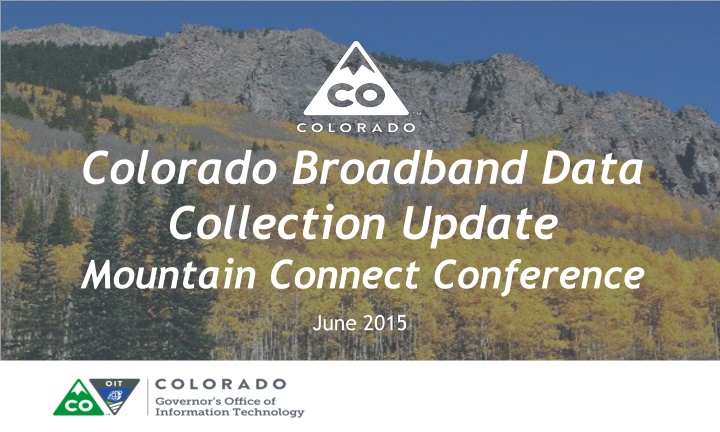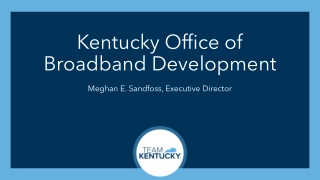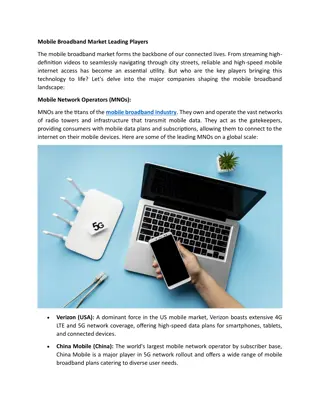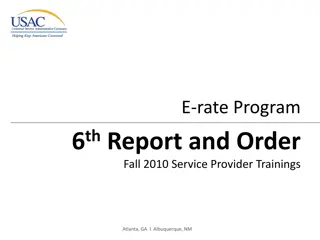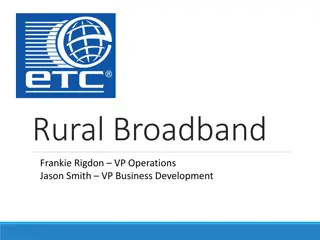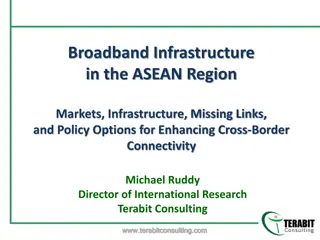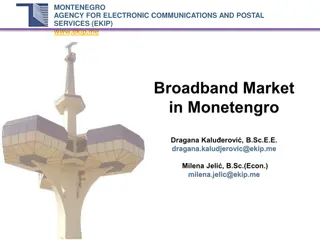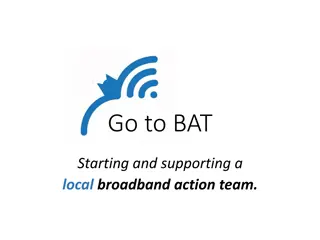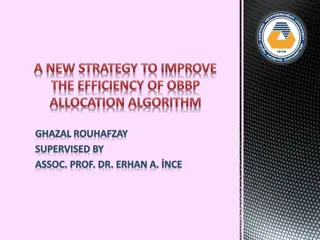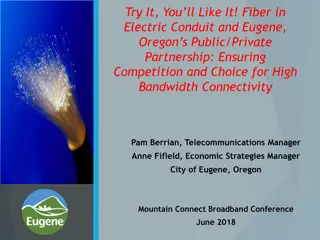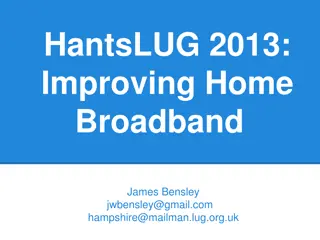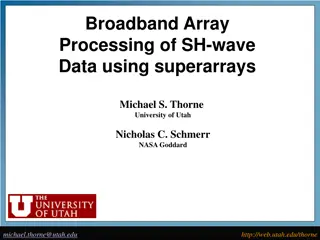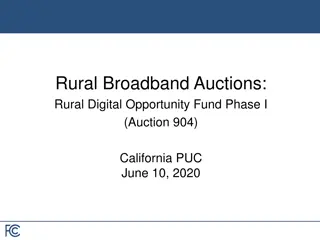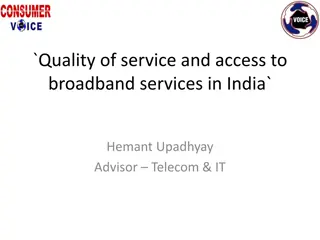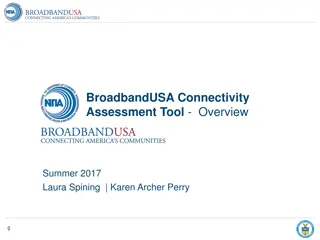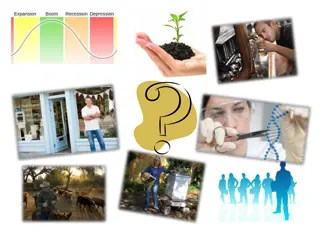Colorado Broadband Data Collection Update and Infrastructure Enhancements
Updating the Colorado broadband data collection process with legislature funding for staff and GIS data coordination. Focus on nuanced data collection for various potential uses such as DOLA grants, broadband planning, and provider marketing. Statewide broadband mapping shows improved speeds for households. Introduction of a new multi-layered database to enhance data confidence and infrastructure information. Preferred data content includes address points, subscription data, tower details, and more. Discussion on Customer Proprietary Network Information (CPNI) and Subscriber List Information.
Download Presentation

Please find below an Image/Link to download the presentation.
The content on the website is provided AS IS for your information and personal use only. It may not be sold, licensed, or shared on other websites without obtaining consent from the author.If you encounter any issues during the download, it is possible that the publisher has removed the file from their server.
You are allowed to download the files provided on this website for personal or commercial use, subject to the condition that they are used lawfully. All files are the property of their respective owners.
The content on the website is provided AS IS for your information and personal use only. It may not be sold, licensed, or shared on other websites without obtaining consent from the author.
E N D
Presentation Transcript
Colorado Broadband Data Collection Update Mountain Connect Conference June 2015
Now Legislature funded staff to continue broadband data collection and some GIS data coordination (addresses) Revising data collection process to be more nuanced and address state potential more Possible uses: oFunding? DOLA grants, other oBroadband planning at local and state level oAnnual state of broadband report o Marketing for providers Still based on data from providers, but other sources as well
State of Broadband Throughout mapping, broadband service: o> 99% households statewide o> 98% rural households o~7/8% households receiving improvement in broadband speeds With 25 mbps down, ~58%
New Database Multi-layered oCommunity Anchor Institution oBroadband service oData confidence oInfrastructure (as collected) Multiple sources oProviders oCrowd Sources oLTPT plans or other data collection Improve and evolve over time
Preferred Data Content Address points with Subscriptions by geographic unit Towers w/propagation model Towers Other data? oResidential price oAdvertised speed oMiddle mile
CPNI (1) Customer proprietary network information The term customer proprietary network information means (A) information that relates to the quantity, technical configuration, type, destination, location, and amount of use of a telecommunications service subscribed to by any customer of a telecommunications carrier, and that is made available to the carrier by the customer solely by virtue of the carrier- customer relationship; and (B) information contained in the bills pertaining to telephone exchange service or telephone toll service received by a customer of a carrier; except that such term does not include subscriber list information. (3) Subscriber list information The term subscriber list information means any information (A) identifying the listed names of subscribers of a carrier and such subscribers telephone numbers, addresses, or primary advertising classifications (as such classifications are assigned at the time of the establishment of such service), or any combination of such listed names, numbers, addresses, or classifications; and (B) that the carrier or an affiliate has published, caused to be published, or accepted for publication in any directory format.
Broadband Data Confidence Mapping Indicates quality of or confidence in data for an area Start with data received from providers: o Address / Subscriber list of current broadband users (high confidence) o Census Block and Roads data (medium confidence) o Deriving coverage based off tower data, radio mobile (medium confidence) o Generalized drawing on a map (low confidence) o Census tracts (low confidence) o Data collected from a provider s website (low confidence) Review data and make necessary changes Confidence then adjusted based on other information such as o Structured feedback from consumers, LTPTs o Speed tests o Infrastructure o Aerial imagery
Depict Confidence in Data as OIT Reviews and Incorporates Other Data (e.g., LTPT feedback) Confidence Service
Fremont County Example Fixed Wireless
Assumptions Data type received will set the starting point for confidence Address / Subscriber list of current broadband users (high confidence) Census Block and Roads data (medium confidence) Deriving coverage based off tower data, radio mobile (medium confidence) Generalized drawing on a map (low confidence) Census tracts (low confidence) Data collected from a provider s website (low confidence) Systematic LTPT/carrier feedback will increase/decrease confidence Cannot receive advertized provider Speeds not as advertized Speed tests that support broadband coverage claims raise confidence Technology type increases/decreases confidence Areas outside of prescribed DSL distance from DSLAMs reduce confidence Low wireless signal strength areas are low confidence Midmile locations supporting coverage increase confidence Known fiber lines in area increase confidence Illogical claims rated low confidence or disregarded Wireline in remote areas Wireless models ignoring topography Low/medium confidence areas will be sent back to provider for review and asked for more evidence
October 2014 (Census Block)
April 2015 (Quarter-Quarter Sections)
Some Stats Heard from 100 total providers out of 118 known possible providers o18 no responses, 10 of which have never participated before o46 new data submissions o45 stated no data changes o9 providers who typically submitted data said get data from FCC o8 providers who submitted data at least once since 2012 did not respond oReprocessed existing data 86.87% households statewide have broadband 59.02% rural households have broadband
Data Feedback First hand experience: o Form on portal http://coloradobroadband.state.co.us/share/broadband-service-report Who did you attempt to obtain service from What was specific response o Speed tests Multiple speed tests at different times OIT speed test or use other speed test and indicate which test on form Geographically/technically verifiable circumstantial information: o COs o tower locations and topography Second hand information: o Infrastructure claims (will need to be researched and verified) Other ideas of good feedback?
Thank You Jon Gottsegen Jon.gottsegen@state.co.us 303-764-7712 Kass Rezagholi Kassrah.rezagholi@state.co.us 303-764-6871
